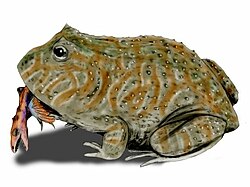ベールゼブフォ
| ベールゼブフォ | ||||||||||||||||||||||||
|---|---|---|---|---|---|---|---|---|---|---|---|---|---|---|---|---|---|---|---|---|---|---|---|---|
 2008年時点での、獣脚類の幼体を捕食するベールゼブフォ復元図 | ||||||||||||||||||||||||
| 地質時代 | ||||||||||||||||||||||||
| 後期白亜紀マーストリヒチアン | ||||||||||||||||||||||||
| 分類 | ||||||||||||||||||||||||
| ||||||||||||||||||||||||
| 学名 | ||||||||||||||||||||||||
| Beelzebufo ampinga Evans, Jones & Krause, 2008 |
ベールゼブフォ(学名:Beelzebufo)は、約7000万年前にあたる後期白亜紀のマーストリヒチアン期のマダガスカルに生息した大型の無尾目(カエル)の属。化石はマエヴァラノ累層から産出した[1]。2008年の記載当初は地球史上最大級のカエルとされていたが、より完全な化石が後に発見され、現生で最大のゴライアスガエルや、チリの始新世の地層から発見された部分化石からのみ知られる未命名種[2]にその座を譲っている。当時の恐竜の幼体を捕食していたとも言われる。
メディアでは悪魔のカエル[3]、悪魔のヒキガエル[4]、地獄からやってきたカエル[5]とも形容される。
命名
[編集]ベールゼブフォは2008年2月に記載・命名された。属名は異教神あるいは悪魔ベルゼブブ(Beelzebub)とヒキガエルの学名である bufo の混成語であり、種小名 ampinga はマダガスカル語で「装甲」の意である。種小名は盾を彷彿とさせる頭部の突起を反映している[6]。
特徴
[編集]
2008年の記載時にはベールゼブフォの体長は42.5センチメートルとされた[1]が、2014年の研究で少なくとも体長23.2センチメートルまで成長したと下方修正された。これは現生のアフリカウシガエルが達しうる大きさである[7]。頭部は非常に大型であった[7]。
生物地理
[編集]ベールゼブフォの化石が産出したマダガスカル島は、後期ジュラ紀の最初期にソマリアの海岸から離れ、またインド亜大陸と繋がっていた[8]。ベールゼブフォは南アメリカ大陸に生息するツノガエル科に姿が類似しており、かつては後期白亜紀まで南アメリカ大陸とマダガスカル、場合によっては南極大陸が陸続きであった可能性も考えられていた[1][7][6]。
しかし、ベールゼブフォはツノガエルと近縁ではなく、姿が類似するのは収斂進化によるものと考えられている[9][10]。かつてツノガエル科に分類されていた他の絶滅したカエルにはバウルバトラクスがおり、ベールゼブフォはツノガエル科と縁遠いネオバトラクス類(Neobatrachia)のより古いグループに属する可能性がある[10]。
生態
[編集]ベールゼブフォは口を大きく広げることができ、比較的大型の獲物を捕食していた可能性が高い。具体的にはトカゲなど小型の脊椎動物のほか、孵化した直後の恐竜の幼体なども獲物の候補に挙がる[6][11]。クランウェルツノガエルに基づく推定では、幅15.4センチメートルの口を持つベールゼブフォの咬合力は500 - 2200ニュートンとされている[12]。
出典
[編集]- ^ a b c Evans, Susan E.; Jones, Marc E. H.; David W. Krause (2008). “A giant frog with South American affinities from the Late Cretaceous of Madagascar”. Proceedings of the National Academy of Sciences of the United States of America 105 (8): 2951–2956. Bibcode: 2008PNAS..105.2951E. doi:10.1073/pnas.0707599105. PMC 2268566. PMID 18287076.
- ^ Otero, Rodrigo A.; Jimenez-Huidobro, Paulina; Soto-Acuña, Sergio; Yury-Yáñez, Roberto E. (2014-11-01). “Evidence of a giant helmeted frog (Australobatrachia, Calyptocephalellidae) from Eocene levels of the Magallanes Basin, southernmost Chile” (英語). Journal of South American Earth Sciences 55: 133–140. doi:10.1016/j.jsames.2014.06.010. ISSN 0895-9811.
- ^ Dybas, Cheryl (2008年2月18日). “Scientists Discover 'Giant Fossil Frog from Hell'”. Press Release 08-025. National Science Foundation. 2008年2月26日時点のオリジナルよりアーカイブ。2008年2月19日閲覧。
- ^ “Scientists find 'Devil Toad' fossil”. Associated Press. (2008年2月18日) 2008年2月19日閲覧。
- ^ Hooper, Rowan (2008年2月18日). “Giant prehistoric frog hints at ancient land link”. New Scientist. 2008年2月26日時点のオリジナルよりアーカイブ。2008年2月19日閲覧。
- ^ a b c 「ベールゼブフォ」ナショナルジオグラフィック。2022年8月16日時点のオリジナルよりアーカイブ。2023年11月29日閲覧。
- ^ a b c Evans S, Groenke J, Jones M, Turner A, Krause D (2014). “New Material of Beelzebufo, a Hyperossified Frog (Amphibia: Anura) from the Late Cretaceous of Madagascar”. PLOS ONE 9 (1): e87236. Bibcode: 2014PLoSO...987236E. doi:10.1371/journal.pone.0087236. PMC 3905036. PMID 24489877.
- ^ Lawrence A. Lawver, Lisa M. Gahagan and Ian w.D. Dalziel, "A tight-fit early Mesozoic Gondwana: a plate reconstruction perspective", 1999, p. 5 "Africa-Madagascar", with citations (on-line text Archived 2008-10-12 at the Wayback Machine.)
- ^ Ruane, S.; Pyron, R. A.; Burbrink, F. T. (2011). “Phylogenetic relationships of the Cretaceous frog Beelzebufo from Madagascar and the placement of fossil constraints based on temporal and phylogenetic evidence: Phylogenetic placement of Beelzebufo”. Journal of Evolutionary Biology 24 (2): 274–285. doi:10.1111/j.1420-9101.2010.02164.x. PMID 21044207.
- ^ a b Báez, Ana María; Gómez, Raúl Orencio. “Dealing with homoplasy: osteology and phylogenetic relationships of the bizarre neobatrachian frog Baurubatrachus pricei from the Upper Cretaceous of Brazil”. Journal of Systematic Palaeontology 16 (4): 279–308. doi:10.1080/14772019.2017.1287130. hdl:11336/21138. ISSN 1477-2019.
- ^ “'Frog from hell' fossil unearthed”. BBC News (2008年2月18日). 2008年2月21日時点のオリジナルよりアーカイブ。2008年2月18日閲覧。
- ^ Lappin, A. Kristopher; Wilcox, S.C.; Moriarty, D. J.; Stoeppler, Stephanie A. R.; Evans, Susan E.; Jones, Marc E. H. (2017). “Bite force in the horned frog (Ceratophrys cranwelli) with implications for extinct giant frogs”. Scientific Reports 7 (1): 11963. Bibcode: 2017NatSR...711963L. doi:10.1038/s41598-017-11968-6. PMC 5607344. PMID 28931936.


 French
French Deutsch
Deutsch